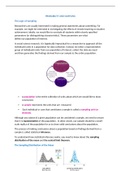Other
Probability and Sampling
- Course
- Research Methods
- Institution
- University Of Cape Town (UCT)
This document contains relevant information pertaining to sampling and probability. As well as validity, Cronbach's Alpha and research strategies.
[Show more]



